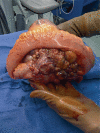Extraordinarily Prolonged Disease Recurrence in a Granulosa Cell Tumor Patient
- PMID: 21060767
- PMCID: PMC2974967
- DOI: 10.1159/000320740
Extraordinarily Prolonged Disease Recurrence in a Granulosa Cell Tumor Patient
Abstract
BACKGROUND: Granulosa cell tumors are rare sex cord stromal lesions that comprise approximately 3% of all ovarian neoplasms. The vast majority of granulosa cell tumors are considered indolent but in spite of aggressive management, delayed recurrence is of significant concern. CASE REPORT: We describe a case involving a 67-year-old woman who presented with abdominal pain, bloody stools, and mild nausea. Following a CT scan of the abdomen and pelvis, a 19-cm pelvic mass was identified. Her prior medical history included a hysterectomy for uterine fibroids 40 years ago and a bilateral salpingo-oophorectomy for a presumed granulosa cell tumor 20 years ago. Final pathology revealed granulosa cell tumor with small bowel mesentery involvement. The patient underwent surgical resection and adjuvant chemotherapy; she is currently doing well. CONCLUSION: Granulosa cell tumors are considered to be of low malignant potential but they have the capacity to recur, even several years following initial patient management. This case exemplifies the disease's capacity for prolonged recurrence and further accentuates the significance of long-term follow-up in these patients.
Figures
Similar articles
-
Palliative Chemotherapy: Does It Only Provide False Hope? The Role of Palliative Care in a Young Patient With Newly Diagnosed Metastatic Adenocarcinoma.J Adv Pract Oncol. 2017 May-Jun;8(4):382-386. Epub 2017 May 1. J Adv Pract Oncol. 2017. PMID: 30018843 Free PMC article. Review.
-
Juvenile granulosa cell tumor in an adult woman during pregnancy: A case report and review of the literature.Gynecol Oncol Rep. 2023 Mar 17;46:101164. doi: 10.1016/j.gore.2023.101164. eCollection 2023 Apr. Gynecol Oncol Rep. 2023. PMID: 36992983 Free PMC article.
-
[Isolated metastasis of the granulosa cell tumor of the ovary in the small intestine mesentery 19 years after salpingo-oophorectomy].Srp Arh Celok Lek. 2006 Nov-Dec;134(11-12):546-9. doi: 10.2298/sarh0612546c. Srp Arh Celok Lek. 2006. PMID: 17304772 Serbian.
-
A case of adult granulosa cell tumor presenting as thoracic lesions.Gen Thorac Cardiovasc Surg Cases. 2023 Apr 21;2(1):14. doi: 10.1186/s44215-023-00038-1. Gen Thorac Cardiovasc Surg Cases. 2023. PMID: 39516796 Free PMC article.
-
Laparoscopic treatment of ovarian granulosa cells tumor developed in the pelvic anterior preperitoneal space 20 years after laparotomic salpingo-oophorectomy: case report and review of literature.Gynecol Endocrinol. 2020 Oct;36(10):926-928. doi: 10.1080/09513590.2020.1716329. Epub 2020 Mar 3. Gynecol Endocrinol. 2020. PMID: 32124640 Review.
Cited by
-
Magnetic Resonance Imaging of Recurrent Adult Granulosa Cell Tumor of the Ovary: A Retrospective Analysis of 11 Cases.J Comput Assist Tomogr. 2020 Nov/Dec;44(6):887-892. doi: 10.1097/RCT.0000000000001096. J Comput Assist Tomogr. 2020. PMID: 32976259 Free PMC article.
References
-
- Duncan TJ, Lee S, Acheson AG, Hammond RH. An ovarian stromal tumor with luteinized cells: an unusual recurrence of an unusual tumor. Int J Gynecol Cancer. 2008;18:172–175. - PubMed
-
- Chan JK, Zhang M, Kaleb V, et al. Prognostic factors responsible for survival in sex cord stromal tumors of the ovary – a multivariate analysis. Gynecol Oncol. 2005;96:204–209. - PubMed
-
- Hasiakos D, Papakonstantinou K, Karvouni E, Fotiou S. Recurrence of granulosa cell tumor 25 years after initial diagnosis. Report of a case and review of the literature. Eur J Gynaecol Oncol. 2008;29:86–88. - PubMed
-
- Hines JF, Khalifa MA, Moore JL, Fine KP, Lage JM, Barnes WA. Recurrent granulosa cell tumor of the ovary 37 years after initial diagnosis: a case report and review of the literature. Gynecol Oncol. 1996;60:484–488. - PubMed
Publication types
LinkOut - more resources
Full Text Sources



